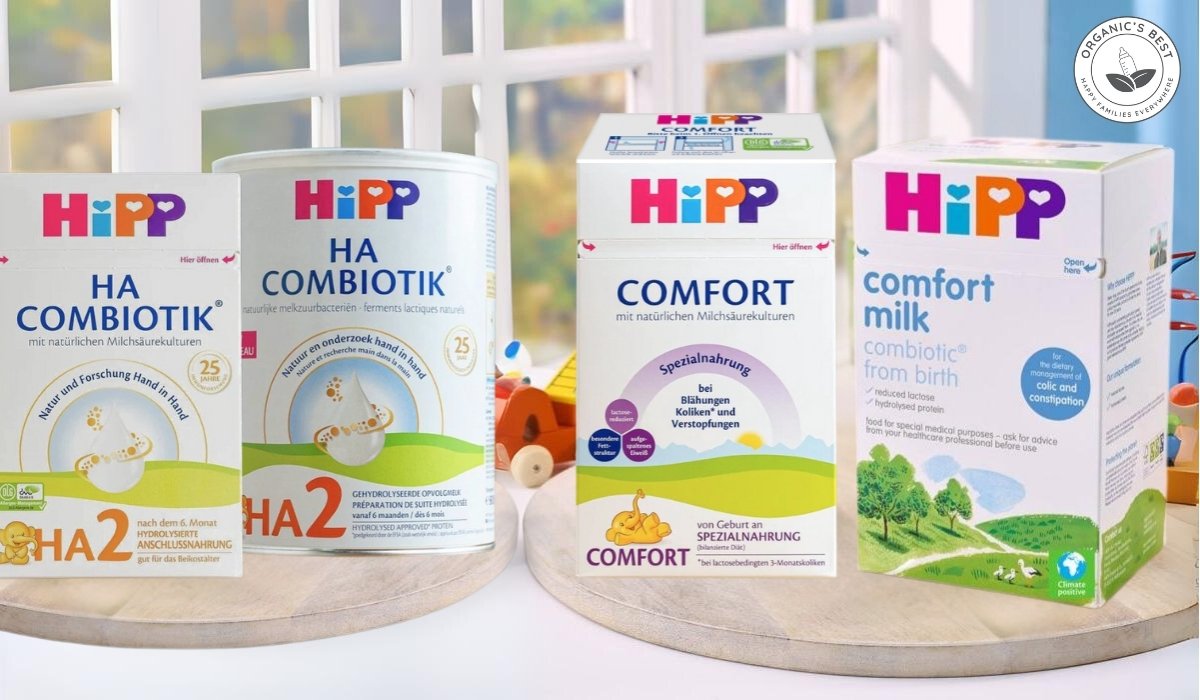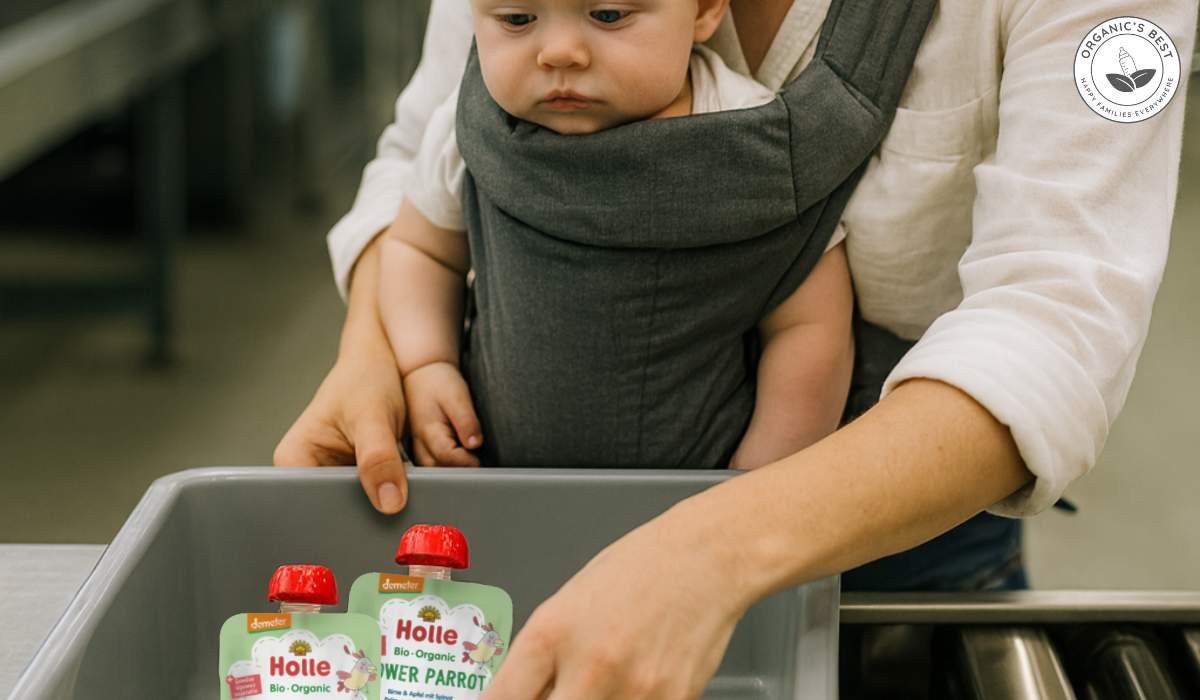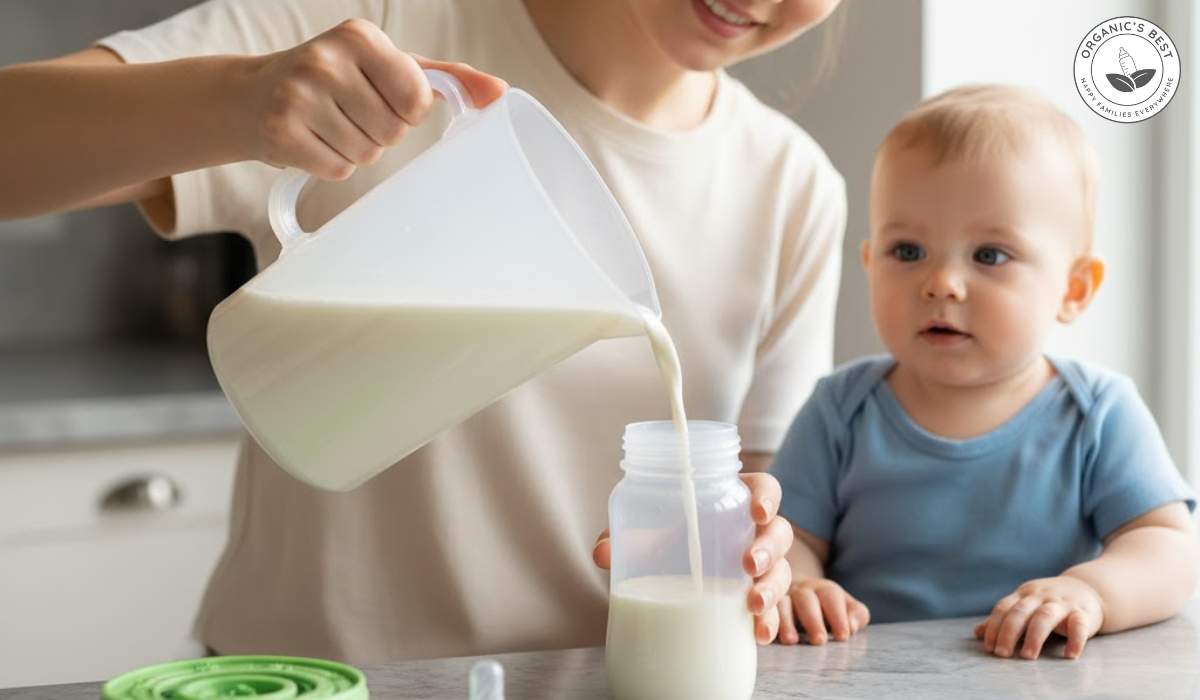Click to Get 2 FREE Boxes/Cans
Only New Customers! Click HERE to Get 2 Extra Boxes/Cans for Free With Your First Order.
BABY FORMULA
Offering new parents top-quality European infant formula from renowned brands like HiPP, Holle, Kendamil, and more. If you’re uncertain about which product to choose, our Formula Finder can help you make the best decision for your baby.
Baby Food
Offering new parents a premium selection of European baby foods, including jars, pouches, cereals, and snacks from esteemed brands like HiPP and Holle.
HiPP Comfort vs HiPP HA: What’s the Difference?
by Agustina Fernandez October 29, 2024 7 min read

Tummy troubles are pretty common during a baby's first year, often caused by the proteins in cow's milk.
Since every baby has different nutritional needs, not all formulas work the same way. If your little one is dealing with digestive issues or food sensitivities, finding the right formula can feel tricky.
That's where special formulas come in. Two popular choices are HiPP Comfort and HiPP HA (Hypoallergenic). Both are hydrolyzed protein formulas designed to help with sensitive tummies, but they each serve different needs.
In this article, we'll explain what makes these formulas unique, how hydrolyzed proteins work, and how to pick the best hydrolyzed baby formula for your little one!
Table of Contents
- Understanding Hydrolyzed Protein: Hydrolyzed Formula Types
- Unique Features of HiPP Comfort
- Unique Features of HiPP HA (Hypoallergenic)
- Similarities Between HiPP HA and HiPP Comfort Formula
- Key Differences Between HiPP Comfort and HiPP HA Formula
- Wrapping Up: Which One To Choose? HiPP HA vs HiPP Comfort
Understanding Hydrolyzed Protein: Hydrolyzed Formula Types
What makes HiPP Comfort and HiPP hypoallergenic formula so special is the use of hydrolyzed protein, but what does that mean?
The National Institute of Health states, "Protein hydrolysis means that proteins are broken down into smaller components or peptides. The size of the peptides determines the classification of a formula as partially hydrolyzed (most peptides with a molecular weight of 3-10 kDa) or extensively hydrolyzed (peptides with a molecular weight of <3. kDa)."
Think of it like this- milk proteins are broken down into smaller forms (either partially or extensively), removing the complex casein proteins. What's left are smaller, easier-to-digest hydrolyzed whey proteins that can help support your baby's digestion.
Since your baby's body is busy working hard to grow, develop, and maintain other functions, this process can take some strain off of the digestive system, which may improve the overall comfort of babies who deal with sensitivities and digestive issues.
The hydrolysis process creates two types of baby formulas based on how much the proteins are broken down:

Partially Hydrolyzed Formula
First, we have partially hydrolyzed formula, in which the proteins are only partially broken down, meaning large protein molecules remain. These can be suitable for babies with mild digestion issues but may not be enough for those with more serious sensitivities or allergies.
Extensively Hydrolyzed Formula
Extensively hydrolyzed formulas, like HiPP Comfort and HiPP Hypoallergenic formula, break down milk proteins into tiny fragments, making them easier to digest. These formulas are often considered for babies with moderate digestive or mild protein sensitivities, but true CMPA may require an amino acid-based formula under medical guidance.
About 15% of infants react negatively to cow's milk protein, with 2-7.5% developing a true allergy. Many outgrow these issues by age 1-3, but that first year can be challenging.
If standard cow or goat milk formulas don't work, these specialized options may help. Hypoallergenic formulas are great for mild sensitivities, but it's best to consult your pediatrician to find the right fit for diagnosed allergies.
Unique Features of HiPP Comfort

If your tiny tot experiences gas, colic, constipation, or general discomfort after feedings, this HiPP hydrolyzed formula may offer some much-needed relief.
HiPP Comfort is available in two versions: UK and German. While both are designed to help manage constipation and colic with similar formulations, they differ slightly.
However, the primary takeaway is that both variations contain mindfully chosen ingredients, which work together to offer gentle support if a traditional cow's milk formula isn't a good fit.
Here are some of the key features:
-
Lactose-based but with reduced lactose content: This reduction helps ease digestion for babies who struggle with lactose (but not lactose intolerance) while still providing the natural benefits of milk sugar.
-
Extensively Hydrolyzed proteins: Hydrolyzed proteins are broken into smaller peptides, making them easier on sensitive tummies and minimizing the chance of discomfort.
-
Prebiotics and Probiotics: Depending on the version (the UK version only contains prebiotics), these gut-friendly fibers (prebiotics) and beneficial bacteria (probiotics) support immunity and digestive health and can help regulate bowel movements.
-
Beta palmitate: Beta palmitate is a high-quality blend of fatty acids extracted from palm oil designed to mimic breast milk's fat profile. It can improve the absorption of calcium and fats, promoting softer stools for easier bowel movements while encouraging a healthy balance of gut microflora and helping to minimize constipation.
-
Not certified organic: While HiPP is known for organic formulas, Comfort doesn't carry this certification because of the specific protein processing required. It is, however, non-GMO.
Unique Features of HiPP HA (Hypoallergenic)

On the other hand, if your baby shows signs of milk protein sensitivity or has a family history of allergies, HiPP hypoallergenic baby formulas might be a better choice. This thoughtfully designed formula supports your baby's immune system while reducing the risk of allergic reactions. It's also free from common allergens, including gluten, soy, nuts, and eggs.
Here are some of the key features:
• Extensively hydrolyzed milk protein: The proteins are broken down to reduce the likelihood of triggering allergic reactions.
• Lactose as the main carbohydrate: While HiPP Comfort uses a blend of starch, maltodextrin, and lactose, HiPP hypoallergenic formula relies primarily on lactose, which helps mimic the composition of breast milk.
• Prebiotics and Probiotics: Both HiPP hypoallergenic German and HiPP hypoallergenic Dutch formulas contain these helpful ingredients to promote a healthy gut and support immunity. Importantly, HiPP HA ready-to-feed has only prebiotics.
• Not designed for babies with diagnosed cow's milk protein allergy (CMPA): It's important to note that while this formula helps with sensitivities, it may not be suitable for babies with confirmed CMPA-consult your pediatrician if you're unsure.
• Fat blend of vegetable oils: HiPP HA includes palm oil, sunflower oil, and rapeseed oil to provide essential fatty acids.
• Not certified organic: Like the Comfort formula, HiPP HA is ineligible for organic certification but remains GMO-free.
Similarities Between HiPP HA and HiPP Comfort Formula
When it comes to HiPP HA vs HiPP Comfort, both are designed specifically for infants with sensitive stomachs or feeding difficulties. Now that we've covered when to use each formula let's explore what they have in common.
Here are a few key similarities:
• Extensively Hydrolyzed proteins: Both formulas make use of these broken-down proteins for easier digestion.
• Prebiotics and Probiotics: Depending on the version, each formula includes these ingredients for enhanced gut and immune health.
• Developed for sensitive digestion: Whether it's colic, constipation, or sensitivity, these formulas are specially designed for sensitive tummies.
Key Differences Between HiPP Comfort and HiPP HA Formula
Though they share some common ground, HiPP Comfort and HiPP Hypoallergenic formula serve different needs and may, therefore, be more well-suited to certain babies than others.
Here's a breakdown of their primary differences:

Carbohydrate Base
HiPP Comfort uses a blend of starch, maltodextrin, and lactose, making it thicker and more filling-great for babies who need extra satiety.
HiPP hypoallergenic baby formula relies on lactose as the primary carbohydrate, better mimicking the composition of breast milk.
Hypoallergenic Properties
HiPP Comfort is not hypoallergenic. It's aimed at easing digestion but isn't designed to reduce allergy risks.
HiPP HA is hypoallergenic, making it a better option if you suspect milk protein sensitivity.
Fat Composition
HiPP Comfort contains beta-palmitate, which supports fat absorption and may help with stool consistency and calcium absorption.
HiPP HA uses vegetable oils (palm oil, rapeseed oil, sunflower oil) to provide essential fatty acids.
Probiotics
HiPP HA includes both prebiotics and probiotics (German and Dutch versions). However, the ready-to-feed version contains only prebiotics, as probiotics are unable to survive the special heat processing that liquid formula goes through.
HiPP Comfort UK only contains prebiotics, without added probiotics, but HiPP Comfort German version has both.
Is HiPP HA More Hydrolyzed Than HiPP Comfort?
Both HiPP HA and HiPP Comfort contain hydrolyzed proteins that are extensively broken down by 86-87%. Extensively hydrolyzed formula typically means that most of the intact proteins are broken into very small peptides, making them less likely to trigger sensitivities. However, they serve distinct purposes.
HiPP Comfort is designed to ease digestive issues like gas and colic, while HiPP HA aims to lower the risk of allergic reactions. They are two different paths to a happier baby, offering relief in their own way!
Wrapping Up: Which One To Choose? HiPP HA vs. HiPP Comfort
When choosing between HiPP Comfort and HiPP HA, it all comes down to your baby's unique needs. If your baby struggles with colic, gas, or constipation, HiPP Comfort could make a noticeable difference. On the other hand, if you're concerned about milk protein sensitivity or a family history of allergies, HiPP HA might be the safer bet.
Remember that both formulas are excellent options for infants with sensitive stomachs. It's always a good idea to talk to your pediatrician before making a switch. They'll help you choose the right path for your little one's health and happiness.
Parenting is full of little decisions. The good news is that whether you choose HiPP Comfort or HiPP HA, you're selecting a high-quality formula trusted by families worldwide.
You know your baby best, and with the right information in hand, you're already one step closer to finding the perfect fit!
|
Disclaimer:
Please be aware that this information is based on general trends in babies, and it is not medical advice. Your doctor should be your first source of information and advice when considering any changes to your child’s formula and when choosing your child’s formula. Always consult your pediatrician before making any decisions about your child’s diet or if you notice any changes in your child. Breastfeeding is the best nutrition for your baby because breast milk provides your child with all the essential nutrients they need for growth and development. Please consult your pediatrician if your child requires supplemental feeding. |
Agustina Fernandez
Dr. Agustina Fernandez earned her medical degree from the prestigious Universidad Nacional de Córdoba, Argentina. With a deep-rooted passion for pediatrics, Dr. Fernandez is currently on the path to specializing in children's healthcare. Recently, she has delved into the vital field of infant nutrition. Her research interests include breastfeeding, infant formula, and baby food in little ones’ formative years. Dr. Fernandez's commitment to this area of study underscores her dedication to ensuring the health and well-being of children from their earliest days.
Leave a comment
Comments will be approved before showing up.
Also in Organic Infant Nutrition and Health Blog

Everything You Need To Know About Winter Pregnancy: Essential Tips for Moms-to-be
by Agustina Fernandez December 16, 2025 8 min read
Read More
Can You Bring Baby Food Pouches on a Plane? Essential Tips for Parents
by Agustina Fernandez December 09, 2025 7 min read
Read More
The Formula Pitcher: Is It Safe To Make A Whole Pitcher Of Baby Formula?
by Agustina Fernandez December 02, 2025 8 min read
Read More
Reviewed by Dr. Bardha Citaku, MD
-

Dr. Bardha Citaku: Medical Reviewer of Organic's Best Blog
Dr. Bardha Citaku completed her medical studies at the University of Prishtina in Kosovo, where she began her journey into the field of medicine. She has since developed a career in medical research, contributing to projects with notable organizations, including the World Health Organization (WHO).
